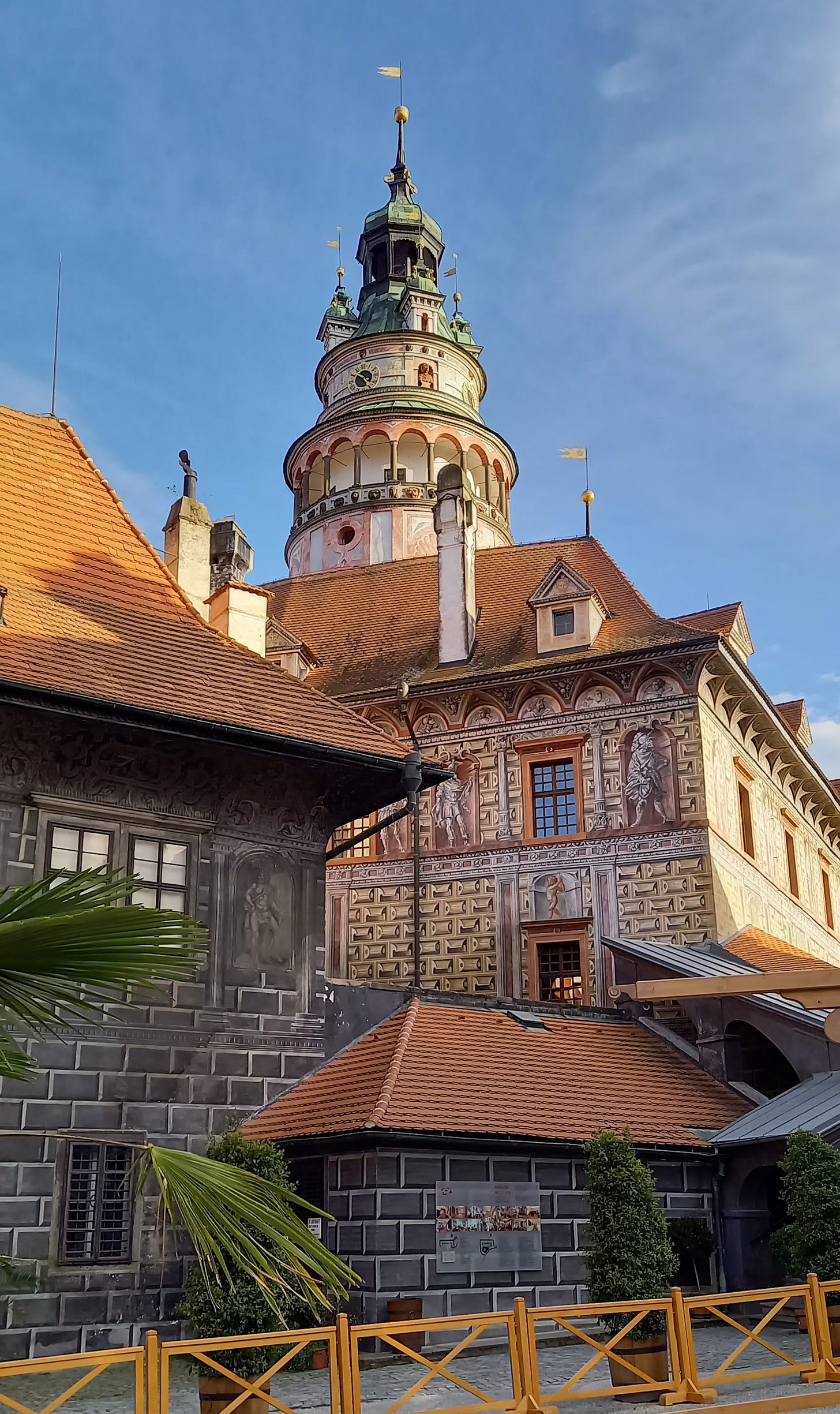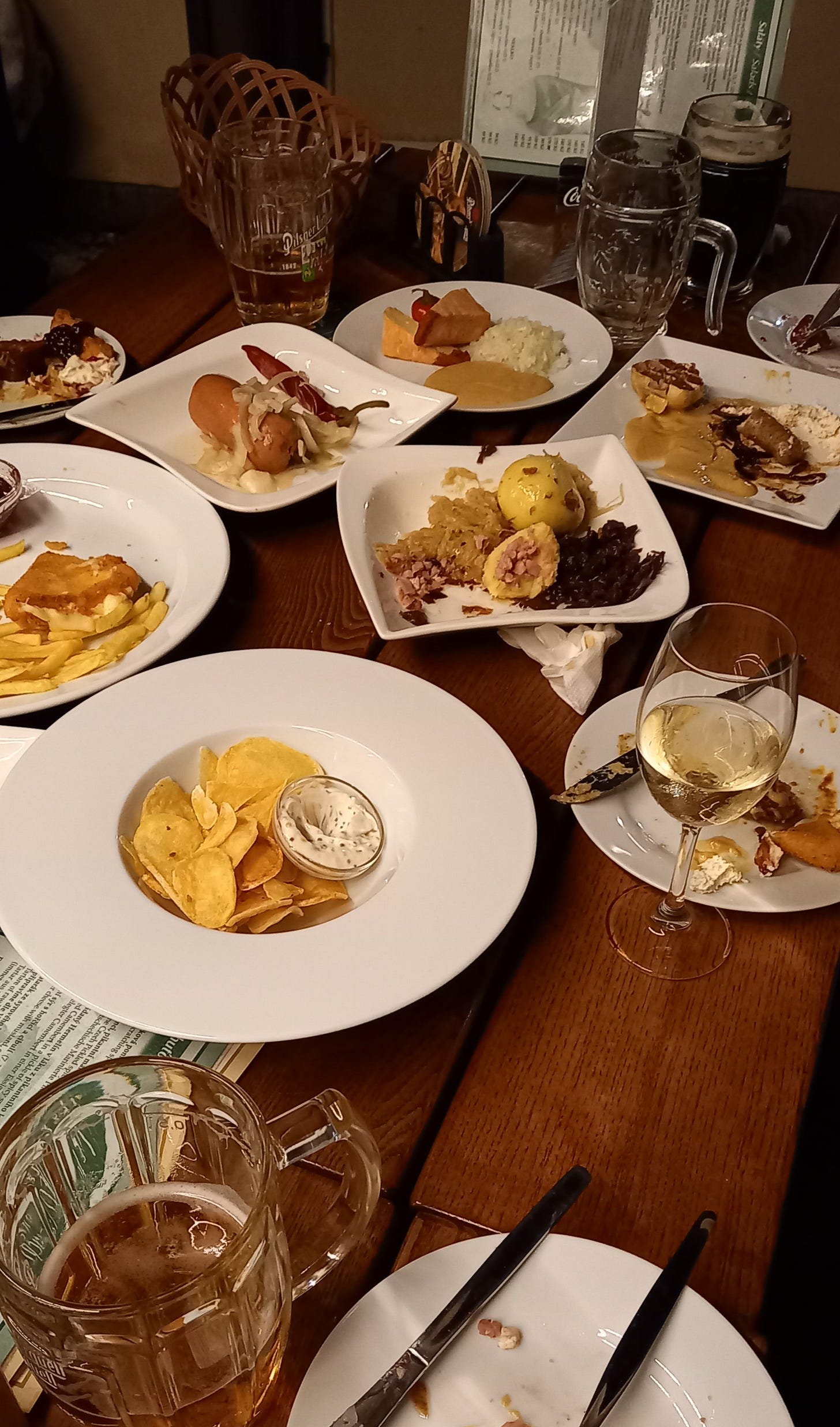Bringing you the Czech
A recipe for Duck, Pork, Prune and Walnut Terrine
Hands up who's heard of Český Krumlov? If you're from the UK or US, I'm guessing there's not much upward stretching going on. On the other hand, if you come from South Korea, Malaysia, Thailand or Taiwan, there will be a pond-weed swaying of limbs.
This tiny and beyond-picturesque town nestling 170 miles south of Prague in the South Bohemia foothills of the Czech Republic, is seething with tourists from South East Asia. How did you hear of Český Krumlov, I quizzed a bunch of students from Seoul. Instagram, they giggled. And from Korean promotions for organised cultural tours.
The town may be protected from wider tourist interest by the fact it’s not flexibly easy to get to - by three-hour train journey once daily from Prague or hired transport. Yet it’s been a UNESCO World Heritage Site since 1992, for its gloriously uplifting Gothic, Renaissance and Baroque architecture.
It's unlikely Insta foodie photos will have enticed many travellers. Unless you're as big a fan as me of all parts of the pig and most things breaded and fried, you probably won't have picked this country for its cuisine. Czech food is the sustenance of winter - insulating ballast. Everything plated is the colour of rust. Nothing comes in green except for a decorative slice or two of cucumber, and those pickled peppers in my delicious but thumping Český Krumlov pork supper of sausages, knuckle, ribs and crackling. This is not a country for vegetarians.
Pork makes up more than half of meat consumed across the land, partly because when compared to beef, the process of its production is relatively short. Schnitzel, flattened, breaded and fried in the Swiss and German fashion, is more commonly made from pork or chicken than from veal.
Český Krumlov specifically may not be familiar to US and UK tourists. But the wider Czech Republic, with its over 2000 glorious castles (not as many per acre as you might think - there are more than 45,000 in France just 7 times the size of Czechia), is a tourist destination rising only slowly in popularity. According to the OECD, 36.3 million people visited in 2017, accounting for a mere 2.9 percent of GDP and 4.5 percent of total employment.
Karlovy Vary, a colourfully elegant 18th century town in west Bohemia and another UNESCO World heritage site, is a more well-known destination.
You could bump into regulars Jude Law or Antonio Banderas, or John Malkovich, Robert De Niro or Renee Zellweger. In your dressing gown, even. It's a spa town. It has countless spa hotels, 12 hot springs and the Pramen Vřídlo geyser which spouts water up to 12 meters high.
As to Prague, the Czech Statistical Office called 2021 a disaster for tourism in the capital, with visitor numbers falling by 71 percent compared to 2019. Most came from Germany or the Czech Republic itself.
Nevertheless, Prague is still a magnet for British stag nights. Men tumble from cheap flights in mini kilts and Groucho Marx spectacles with what are not pink noses attached. Women on hen party weekends deplane in tiny tutus and fairy wings.
They are more likely to have chosen the capital for its excellent beer than its food. Czech beer snacks are far superior to mingey British bowls of salted nuts and chips.
Czech food is comfort food rather than refined, a thrifty cuisine based on reliably available ingredients - potatoes, cabbage, roots and legumes stewed into submission. In this part of the world, kitchen labour has traditionally focused on the preserving of summer produce for harder seasons or times.
Regular dumplings couldn’t be further from Chinese versions, thick pallid slices resembling bread and served steamed with the main meat dish to soak up its thick gravy. Though these tennis balls in the photo are a little fancier, they are still substantial, filled with chopped sausage, or cheese and spinach, or a Nutella-type paste; basically, more wodge.
Some are lighter, made with potato like larger gnocchi, though these, too, can be stuffed. As I was, for most of my trip.
Any Brit forced to eat their youth away at a British boarding school will be in heaven in a Czech restaurant. Though perhaps not without exceptions. There’s a meat dish called Tlačenka in which small scraps of meat are boiled into mush then bound in aspic and served with onion, vinegar and bread. Jelito is a sausage contrived from pig’s blood and meats ground from the pig's head, belly and offal, all compacted together with lard and grains or white bread. Not so different from the haggis method, really, but I can’t see Czech cuisine seducing London’s or New York’s terminally hip foodies any time soon. Still, it wasn’t so long ago that the Brits were despised for their own version of brown food, and now look at contemporary British cuisine!
You’d be missing a trick if you didn’t put a trip round Bohemia on your bucket list. Who wouldn’t want to tell people they were going on a Bohemian holiday? The countryside is stunning, the beer the best (the difference between genuine Budvar in CZ and Budweiser, its US imitation, is silk and sisal), and if you want a foodie tour, there is an upswell of young chefs tweaking traditional recipes into lighter dishes. Vintners are making intriguing wines from grapes varietals I’d never heard of. Plus, it’s heaven for pork enthusiasts.
Here’s a rough pork pâté that wouldn’t be unrecognisable to a Czech diner. It’s made from roughly minced pork meat layered with duck, prunes and walnuts.
Serves 10-12
2 duck breasts, about 300g/10½ oz each, skin removed and reserved
200g/7oz thinly sliced streaky bacon rashers
1 kg/2.2 lbs pork shoulder, cubed
2 slices bread, crusts removed
100ml/5¾ tablespoons milk
3 shallots, roughly chopped
1 large garlic clove, roughly chopped
200g/7oz duck or chicken livers, roughly chopped
6 black peppercorns
12 coriander seed
2 cloves
2 tablespoons Cognac or brandy
2 eggs, beaten
1 teaspoon salt or more to taste
60g/2oz walnuts, roughly chopped `
12-14 pitted Prunes d’Agen or regular prunes, roughly chopped
Preheat oven 160C/320F.
Roast duck breasts and skin in a shallow dish 20 minutes. Pour off fat into a bowl, discarding skin. Reserve 6 bacon rashers. Roughly chop the rest and the cooked duck. Mince all meats to a coarse texture in a processor or meat mincer, in batches. Tip into a large bowl.
Tear up bread and soak in the milk 5 minutes. Squeeze out milk and process bread to a coarse texture in processor with shallots, garlic and livers. Add to bowl.
Grind peppercorns, coriander seeds and cloves to a rough powder. Add to meats with 4 tablespoons reserved duck fat, Cognac, eggs and 1 teaspoon salt. Mix everything thoroughly with your hands.
Press half the mixture into a 3¼ pint/ 1.5-litre loaf tin. Scatter over walnuts and prunes. Cover with remaining meat mixture. Lay reserved bacon rashers over the top, folding ends under. Cover the dish tightly with foil, put in a roasting tin and pour boiling water into the tin to come halfway up the sides of the tin.
Bake 2 hours, remove foil and bake for 15 minutes more to brown the top. Cool completely, then wrap in fresh foil and chill at least 2 days to mature.












You did it again, my dear. Brava!
Not being a massive beer drinker, or a meat eater, I wasn't expecting to enjoy Prague as much as I did! But then I discovered that not only do they make fabulous wines, but they also have a decent Vietnamese expat community, many of whom own restaurants. SAVED!